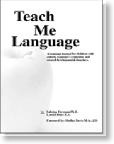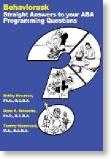iPoint and iPad are not autism treatments
30/10/11 15:53
Since when did communicating in a non-verbal way become a “emerging treatment?” Here is one in many examples demonstrating how the National Standards Report does not understand the genuine meaning of autism treatment. Is a blind person who uses Braille deemed to be receiving “Braille treatment?” Of course not. The contention would be deemed absurd. It is equally absurd to propose that non-verbal communication efforts and innovations for persons with autism somehow constitute a form of treatment for the disorder. I understand the urge of academics who work in this area to elevate their research to the level of autism treatments, but in my view this is a fundamentally dishonest thing to do.
What exactly is “Augmentative and Alternative Communication Device” treatment? It is defined by the National Standards Report as the use of “high or low technologically [sic] sophisticated devices to facilitate communication”. Allow me to translate: the use of pictures, photographs, symbols, books, computers/iPads to be able to communicate is apparently a definition of an autism treatment. If typing on a computer is a form of “communicative treatment,” then everyone who spends time on a computer is receiving “keyboard treatment.” Perhaps, we should get our health insurance companies to pay for our computers, since typing can be defined as a form of treatment!
There are two serious questions that need to be addressed: 1) Should children with autism be using these computers as communicative devices? If so, 2) Which children with autism should be using these non-verbal devices to communicate?
If a child has to use a device like this permanently, then we have failed to teach him/her to communicate as does 99% of the world. Some children may not be able to communicate without a device; however, I am of the view that a child afflicted with autism must have every opportunity to learn to communicate without reliance on either a device or sign language prior to introducing these alternatives. We don’t know whether the child can learn to orally communicate until we have provided the child a way to master the very difficult skill of oral communication. Only then should we resort to non-verbal ways of communicating.
That said, sign language and any kind of communication device should not be elevated to the level of treatment. Those behind the National Standards Report should know better!
What exactly is “Augmentative and Alternative Communication Device” treatment? It is defined by the National Standards Report as the use of “high or low technologically [sic] sophisticated devices to facilitate communication”. Allow me to translate: the use of pictures, photographs, symbols, books, computers/iPads to be able to communicate is apparently a definition of an autism treatment. If typing on a computer is a form of “communicative treatment,” then everyone who spends time on a computer is receiving “keyboard treatment.” Perhaps, we should get our health insurance companies to pay for our computers, since typing can be defined as a form of treatment!
There are two serious questions that need to be addressed: 1) Should children with autism be using these computers as communicative devices? If so, 2) Which children with autism should be using these non-verbal devices to communicate?
If a child has to use a device like this permanently, then we have failed to teach him/her to communicate as does 99% of the world. Some children may not be able to communicate without a device; however, I am of the view that a child afflicted with autism must have every opportunity to learn to communicate without reliance on either a device or sign language prior to introducing these alternatives. We don’t know whether the child can learn to orally communicate until we have provided the child a way to master the very difficult skill of oral communication. Only then should we resort to non-verbal ways of communicating.
That said, sign language and any kind of communication device should not be elevated to the level of treatment. Those behind the National Standards Report should know better!













